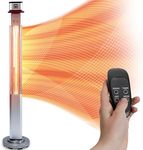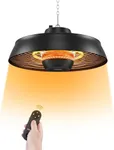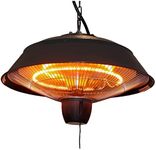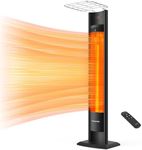Buying Guide for the Best Patio Heaters
Choosing the right patio heater can make your outdoor space comfortable and enjoyable, even when the temperature drops. The key is to match the heater’s features to your space, climate, and how you plan to use it. Think about the size of your patio, whether you want something portable or permanent, and how much warmth you need. Understanding the main specifications will help you make a smart choice that keeps you cozy without wasting energy or space.Heating Power (BTUs or Watts)Heating power tells you how much warmth the patio heater can produce, usually measured in BTUs (British Thermal Units) for gas heaters or watts for electric ones. This is important because it determines how large an area the heater can keep warm. Lower BTU or wattage heaters are best for small patios or for use by just a few people, while higher values are needed for larger spaces or gatherings. To pick the right one, consider the size of your outdoor area and how many people you want to keep comfortable. If you have a small balcony, a lower-powered heater will do, but for a big backyard, look for something with more heating power.
Fuel TypePatio heaters can run on propane, natural gas, or electricity. This spec is important because it affects convenience, installation, and running costs. Propane heaters are portable and easy to set up, making them great for flexibility, but you’ll need to replace tanks. Natural gas heaters are more permanent and require a gas line, but they’re convenient if you want a fixed solution. Electric heaters are simple to use and safe for covered spaces, but they need access to an outlet. Choose the fuel type based on your setup: if you want to move the heater around, go for propane; if you want a permanent fixture, natural gas is best; and if you have a covered or enclosed patio, electric is usually the safest.
Heating Coverage AreaThis spec tells you how much space the heater can effectively warm, usually given in square feet or meters. It’s important because you want to make sure everyone in your seating area feels the heat. Small heaters might cover 50-100 square feet, while larger ones can handle 200-300 square feet or more. To pick the right coverage, measure your patio and think about where people will be sitting. If you have a large area, you might need more than one heater or a model with a bigger coverage range.
Safety FeaturesSafety features include things like tip-over protection, automatic shut-off, and cool-touch exteriors. These are important for preventing accidents, especially if you have kids or pets around. Some heaters will automatically turn off if they get knocked over or if the flame goes out. When choosing, think about who will be using the patio and how much supervision there will be. If safety is a top concern, look for models with multiple safety features.
Portability and DesignPortability refers to how easy it is to move the heater around, while design covers the style and how it fits into your outdoor space. This matters if you want to rearrange your patio or store the heater when not in use. Some heaters have wheels or are lightweight, making them easy to move, while others are heavy and meant to stay in one place. Design can range from tall, freestanding models to tabletop or wall-mounted options. Choose based on how often you’ll move the heater and what looks best in your space.
Weather ResistanceWeather resistance means how well the heater can handle outdoor conditions like rain, wind, and sun. This is important for durability and safety. Some heaters are made with rust-resistant materials or have covers to protect them from the elements. If your patio is exposed to the weather, look for a heater that’s built to withstand it. If your space is covered, you might not need as much weather protection.


















